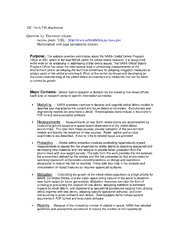
NASA Technical Reports Server (NTRS) 20060010506: JSC Orbital Debris Website Description PDF
Preview NASA Technical Reports Server (NTRS) 20060010506: JSC Orbital Debris Website Description
JSC Form 548 attachment Question 3.c Electronic release: Access point: URL: http://www.orbitaldebris.jsc.nasa.gov Multicontent web page information follows: Purpose: The website provides information about the NASA Orbital Debris Program Office at JSC, which is the lead NASA center for orbital debris research. It is recognized world-wide for its leadership in addressing orbital debris issues. The NASA Orbital Debris Program Office has taken the international lead in conducting measurements of the environment and in developing the technical consensus for adopting mitigation measures to protect users of the orbital environment. Work at the center continues with developing an improved understanding of the orbital debris environment and measures that can be taken to control its growth. Major Contents: Orbital Debris research is divided into the following five broad efforts. Each area of research contains specific information as follows: • Modeling - NASA scientists continue to develop and upgrade orbital debris models to describe and characterize the current and future debris environment. Evolutionary and engineering models are described in detail. Downloadable items include a document in PDF format and executable software. • Measurements - Measurements of near-Earth orbital debris are accomplished by conducting ground-based and space-based observations of the orbital debris environment. The data from these sources provide validation of the environment models and identify the presence of new sources. Radar, optical and surface examinations are described. External links to related topics are provided. • Protection - Orbital debris protection involves conducting hypervelocity impact measurements to assess the risk presented by orbital debris to operating spacecraft and developing new materials and new designs to provide better protection from the environment with less weight penalty. The data from this work provides the link between the environment defined by the models and the risk presented by that environment to operating spacecraft and provides recommendations on design and operations procedures to reduce the risk as required. These data also help in the analysis and interpretation of impact features on returned spacecraft surfaces. • Mitigation - Controlling the growth of the orbital debris population is a high priority for NASA, the United States, and the major space-faring nations of the world to preserve near-Earth space for future generations. Mitigation measures can take the form of curtailing or preventing the creation of new debris, designing satellites to withstand impacts by small debris, and implementing operational procedures ranging from utilizing orbital regimes with less debris, adopting specific spacecraft attitudes, and even maneuvering to avoid collisions with debris. Downloadable items include several documents in PDF format and executable software. • Reentry - Because of the increasing number of objects in space, NASA has adopted guidelines and assessment procedures to reduce the number of non-operational spacecraft and spent rocket upper stages orbiting the Earth. One method of postmission disposal is to allow reentry of these spacecraft, either from orbital decay (uncontrolled entry) or with a controlled entry. Orbital decay may be achieved by firing engines to lower the perigee altitude so that atmospheric drag will eventually cause the spacecraft to enter. However, the surviving debris impact footprint cannot be guaranteed to avoid inhabited landmasses. Controlled entry normally occurs by using a larger amount of propellant with a larger propulsion system to drive the spacecraft to enter the atmosphere at a steeper flight path angle. It will then enter at a more precise latitude, longitude, and footprint in a nearly uninhabited impact region, generally located in the ocean. • Additional information on the website includes The Orbital Debris Quarterly News which is a publication of the NASA Orbital Debris Program Office. It is published four times a year and is available in downloadable PDF files. Each newsletter contains information on some of the latest events in orbital debris research. The sections of the newsletter are news, project reviews, meeting reports, orbital debris statistics, and upcoming events. The newsletters are filled with illustrating graphs, charts and pictures. • Other links are provided to the Orbital Debris Photo Gallery, Frequently Asked Questions and Reference Documents which are downloadable in PDF format. External links to related orbital debris information are also included within the website. Planned frequency of change: • Updates to the website will be performed quarterly for the inclusion of the latest version of the Orbital Debris Quarterly News. • Other updates will be performed about twice a year, primarily to include the latest information associated with orbital debris research, documents and models.
